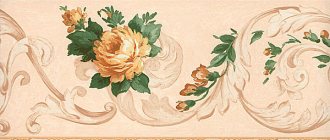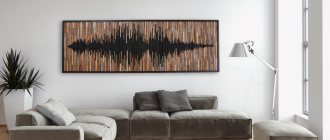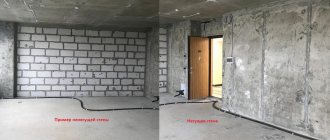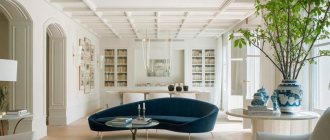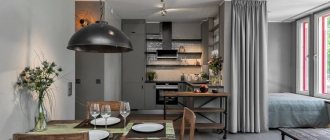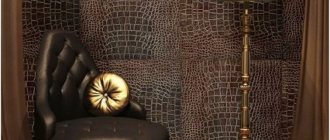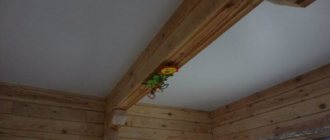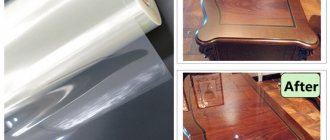SHARE ON SOCIAL NETWORKS
FacebookTwitterOkGoogle+PinterestVk
Much attention is paid to wall decoration in modern interiors. Often, owners of houses and apartments strive to add stylish and bohemian shapes to the interior. This can be done using classic and labor-intensive stucco, or use a more affordable option - apply moldings to the wall. What kind of material is this, what is it made from and how is it used in decoration? The answers to these questions can be found below.
Decorating walls with moldings helps create a sophisticated ambience
Functional and practical purpose of wall moldings
Wall molding is a decorative detail in the form of a three-dimensional strip, which is used to mask flaws, zoning a room by separating different types of finishing materials. Beautiful relief patterns on the walls create an original interior.
Moldings help to very skillfully hide defects on the walls
Moldings, due to the variety of materials used and their wide range of applications, have become especially popular recently. The main function of such details is their decorative effect. Decorating walls in this way helps create a sophisticated ambiance while highlighting the style of decoration and design elements. In addition, moldings perform a number of secondary, but no less important functions, in particular:
Conspiratorial. Decorative strips help to skillfully hide defects on the walls or disguise the boundaries of a secret door. Decorating with moldings will help distract attention from unevenness on the wall or errors in the corners.
Dividing the premises into functional zones. Decorating the wall with moldings will allow you to separate the part of the room with decorative plaster finishing from the other part, where the wall is covered with textured wallpaper.
Wall moldings are easy to care for; just wipe them with a damp cloth or sweep away the dust with a broom
Very often, designers use such decor to create original compositions where one of the walls is highlighted, or to smooth out the contrast in color transitions, as well as to disguise joints. In addition, decorative moldings are used to create panels or photo frames.
The main advantages of using moldings in the interior
As mentioned above, moldings in the interior are not only decorative, but also practical. They are light weight and easy to install. They can be used on different surfaces. Look good in various interior styles.
Helpful advice! Decorating walls with moldings to create exquisite patterns on the walls is much more affordable than traditional plaster molding, which costs several times more and requires a lot of installation time. If everything is done in accordance with the instructions, then visually these two types of decor cannot be distinguished.
Using moldings you can make frames for pictures, mirrors and arches
Based on the list of functions that these decorative items perform, we can highlight a fairly wide range of their advantages:
- Masks surface imperfections. Relief details on the wall will perfectly hide places of damage and help smooth out the transition between materials of different textures.
- Smooth transition in wall decoration with materials that are contrasting in color. This advantage of the moldings is ensured by their light coloring. They can be coated with various types of paint and any color.
- Affordable price. Modern manufacturers offer a variety of materials that have different textures and costs. The most popular are polyurethane moldings, which are characterized by their low price and excellent wear resistance.
- The simplicity of the process of finishing walls with moldings. The flat side of the back allows for reliable fastening of the product to different surfaces. To do this, you just need to apply glue and lean the molding against the wall, holding it for a few seconds.
- Easy to care for. It is enough to wipe the molding with a damp cloth or sweep away the dust with a special broom.
Moldings provide a smooth transition between different materials or contrasting areas
At the intersection of different materials
If tiles or wall panels are laid only on part of the wall, the transition from tiles/plastic to a flat wall does not look very presentable. In order to make this transition more attractive, they use special border tiles, but they are too expensive - much more expensive than regular ones. No less interestingly, you can design this joint using molding. The decorative strip is mounted so that it covers the joint.
If the tiles do not lie up to the ceiling, the transition can be made using molding
The width and thickness are selected for the specific interior and the thickness of the materials being joined. Since we are usually talking about a bathroom, toilet or kitchen, it is more advisable to use materials that are easy to clean and are not afraid of high humidity. The optimal choice for tile joints is polyurethane. It can then be painted the same color as the wall or tile.
The transition from one material to another is best accomplished using molding
If you are decorating the transition between plastic panels and a painted/bleached wall, you can use a plastic plinth. Wooden panels or MDF panels are best joined to walls using wooden moldings.
The same technique works very well when you have to combine two colors or two textures. Moldings are used to separate and harmonize joints. This can be an accent wall, which is very fashionable now.
You can separate material of a different color using moldings
But an accent wall doesn't have to be a different color or pattern from start to finish. It is for such a case - if a canvas or material of a different color occupies only part of the wall - that moldings come in handy. They give a finished look to this finishing element.
Variety of decorative wall moldings
Taking into account the desires of consumers, as well as market demand, manufacturing plants produce various types of moldings. There are several classifications of this popular material used for decorating walls and ceilings. Moldings are distinguished by structure, shape, plasticity, scope of application, type of material used and nature of painting.
In particular, when it comes to shape and size, moldings can be raised or flat. The most popular model is considered to be a product up to 240 cm long. However, there is no standard width, just like there are no minimum or limited sizes of planks. The shape can also be completely different.
From the point of view of the plasticity of the material, flexible and hard moldings are distinguished. It’s worth noting right away that the first type is much more practical, but the price is also significantly higher, so you should seriously think about the advisability of purchasing them.
Wall moldings can be raised or flat
Moldings on the walls in the interior can be colored, plain or painted. The last option is the most popular due to the following advantages:
- the ability to divide walls into zones;
- the ability to create a color accent;
- color selection in accordance with the color of the base material.
Depending on their purpose, products are divided into the following types:
- ceiling moldings;
- wall;
- platbands for doors and windows;
- mirror frames;
- skirting boards;
- cornices;
- wall panels.
In addition, there are separate decorative elements for arches, windows, and furniture.
A separate subtype of moldings are groove strips, which are used as connecting elements between the bathtub and the wall.
For design in a modern style, smooth and strict panels are suitable
Helpful advice! Colored strips should be used very carefully so that decorative moldings for walls in the interior do not create a motley picture due to an excessive abundance of shades.
How to make molding with your own hands: instructions
Wall molding is often done independently, without the help of highly qualified craftsmen. There is nothing complicated about this: all that is required is a few tools and knowledge of a clear work algorithm.
Prepare the necessary equipment in advance so that it is at hand. Also mark the wall surface to prevent incorrect gluing: it will not be possible to remove the molding from the lined surface without leaving a trace. Therefore, make sure that everything is smooth and neat.
Preparing tools
It is simply impossible to make decorative wall molding without specially selected tools. Therefore, we will need to stock up on appropriate equipment.
Step-by-step work
First of all, you will need to measure the required length of the moldings and cut them according to the specified parameters. Using a miter box, cut the corners.
After this, we glue the corner parts in the corners and then install the even ones: follow the notes you made in advance.
If even after all the parts are glued, there are gaps, we recommend lubricating them with the same adhesive composition. It should take at least 24 hours for it to completely harden.
Materials for making moldings: features of use in wall decor
One type of classification of moldings involves the raw materials used in production. Both light and rather heavy materials are used here. How certain models look in different interiors can be judged by photos of moldings on the walls, and the advantages and disadvantages of all materials are shown by the data provided in the table.
| Material used | Advantages | Flaws |
| foam moldings | low price; ease; easy installation | used for decorating perfectly smooth surfaces; high level of fire hazard; toxicity; easily damaged |
| wood planks | environmental friendliness; possibility of painting; ease of cleaning; durability; strength | weightiness; complexity of installation with additional fastening; the need for treatment with special means to protect against pests |
| gypsum products | the ability to choose textures and patterns; strength; high aesthetic qualities; able to highlight different styles | large mass; high price; complexity of installation; do not fit into the decor of a small apartment |
| polyurethane moldings for walls | small weight; durability; ease of installation; flexible surface that allows you to decorate uneven surfaces with curves; affordable price; wide selection of models | low environmental safety |
| polystyrene | moisture resistance; possibility of painting; ease; low price | low elasticity; poor resistance to damage |
| metal moldings for walls | strength; durability; originality | inflexible; fits only into modern styles |
| plastic moldings | water resistance; wide choice of colors and shapes | it is impossible to apply paint; toxicity; low strength |
Wide range of applications for polyurethane moldings
Thanks to modern technologies, such an easy-to-use material as polyurethane has been invented. It has become an excellent analogue of traditional plaster, with which you can easily recreate classic lines in the design of different interiors.
Flexible polyurethane moldings are of particular value. Rubber is used in their production, which gives the product the necessary qualities. This is an excellent solution for decorating walls with radius and curved surfaces: such a plank can be easily bent in any direction and fixed in the desired position.
Polyurethane moldings are the most versatile and practical
Polyurethane moldings will also help hide minor defects. They are used in decorating arches, columns, curved walls and ceilings with cornices. Installing moldings between the walls will eliminate unevenness. This also applies to doorways and mirrors.
Interesting to know! Moldings made of marble, plaster or wood are quite rare in modern construction. They are used mainly for restoration of the interiors of historical and other buildings in order to preserve authenticity. Such products are not only expensive, but also require special attention in terms of care.
Most often, polyurethane decorative elements are used in interior design in a classic style. At the same time, a variety of plank options and design approaches allow them to be successfully used in other stylistic directions. When decorating rooms, such products will ideally fit into different places and surfaces.
For interiors in a classic style, polyurethane moldings are most suitable
Application of polyurethane molding
Due to their flexibility, polyurethane moldings can be used in a wide variety of locations. When decorating ceilings, you can use them to create entire compositions. This does not require the help of a specialist. This option is especially relevant if gypsum stucco is unaffordable and you are bored with a flat ceiling. One of the areas of successful use of polyurethane molding is as a ceiling plinth.
The use of polyurethane strips will help create various patterns, ornaments on the ceiling, and zone the room. For this purpose, it is enough to apply markings and, using special glue for polyurethane moldings, attach the parts along the contour.
On walls, polyurethane molding is used in a number of options:
- in the design of doorways;
- in a combination of a number of elements, decorating the mirror frame, door and trim in the same design;
- as a way to create a false window on a large wall by framing photo wallpaper covered with plexiglass.
Polyurethane moldings on the walls can be colored or painted
Polyurethane parts will be an excellent solution for creating decor on furniture. For example, you can give new life to an old cabinet by framing it with moldings and painting it with silver or gold leaf. With their help, you can make frames for pictures, mirrors and arches - this is another successful option for using polyurethane moldings for wallpaper. A wide selection of products is provided by a variety of patterns and color combinations. Moldings for wallpaper on the wall look especially impressive in places where different types of wallpaper are differentiated.
Related article:
Plastic panels for walls: photos, types and installation methods
Installation of plastic wall panels on wooden and metal sheathing using moldings.
Options for using moldings on walls in the interior: photos of original solutions
Moldings are used in the design of different rooms and functional areas. The most common is the use of moldings on the walls in the interior of the living room. Photos, of which there are many on the Internet, clearly demonstrate this. In this case, experts recommend adhering to the following rules:
- In low-ceiling rooms, it is better to avoid decorating the ceilings with wide, contrasting ceiling plinths. A laconic material to match the ceiling would be more appropriate here.
- In small living rooms, narrow slats of small sizes look great, and in spacious ones, wide and massive ones.
- Moldings should fit perfectly into the overall style of the interior and be harmoniously combined with the entire decor.
- It is better to choose decorative elements in opposite proportions. Low ceilings will go well with vertical narrow moldings on the wall, and horizontal panels are appropriate in a room with high ceilings.
Small narrow moldings look great in small bedrooms
Helpful advice! You need to use colored moldings in doses so that the various color shades do not oversaturate the interior.
These recommendations are also relevant when using moldings on the walls in the bedroom. But in the design of kitchens, the use of this type of decoration is excluded, which is primarily due to practicality, in order to avoid the accumulation of dirt and carbon deposits on convex elements.
Wall decor using moldings: combination with other materials
Moldings go well with various finishing materials, in particular:
- decorative plaster;
- varnish and paint;
- wallpaper;
- elements made of wood and MDF.
The use of moldings allows you to successfully zone the space, creating different geometric shapes and figures. For example, wallpaper molding on the walls will help to highlight individual sections with texture. You can simply use different paint colors if you are using paintable wallpaper. This combination of materials makes it possible to imitate panels.
Wood moldings have a chic look, are easy to clean and durable
Nowadays, the trend is a combination of coatings that are different not only in color and texture, but also in composition. For example, the transition from a painted wall in the kitchen area to a wall covered with wallpaper in the living room will be perfectly brightened up by moldings. In this case, they will become an indispensable tool in zoning rooms and distinguishing one material from another.
To create a design in a modern style, you should choose smooth, strict panels, and to decorate an interior in a luxurious classic style, elements with stucco are ideal. In this case, moldings for interior doors in the form of platbands are often used. A harmonious combination will ensure the selection of planks, doors and baseboards in the same tone.
Molding frames will allow you to visually enlarge small windows. To do this, you need to perform one simple but successful trick - cover the entire area with light curtains, and not just the area where the windows are located.
The competent creation of geometric compositions from moldings will help to refresh the room. Before gluing moldings to a wall with wallpaper, carefully consider the location of the sections and furniture arrangement. This design design is more typical of the classics.
Geometric compositions on the walls made of moldings will help refresh the room
Design ideas
You can quickly change the interior of a room by lightly decorating the ceiling and walls, door and window openings, furniture and communications with overlays. For example, interior doors or arched openings will visually become wider and higher if you glue strips around the perimeter of these elements and paint them the same color.
To visually raise the ceiling, the following method is used: two parallel linings (wide or narrow - depending on the area of the room) at a distance of 30-50 mm from each other are attached to the wall under the ceiling.
Zoning a wall with decorative skirting boards uses many non-standard techniques. Thus, the lower decorative zone is separated from the upper part of the wallpaper, false windows are decorated or large photographs and paintings, wall paintings, fabrics and inserts from other materials are inserted into molding frames, posters and other design compositions are decorated.
Another option for using overlays is multifunctional designs. This could be a shoe holder, a bookshelf, a stand for photos and home accessories or electronic gadgets, a stand for a table clock, a frame for a wall-mounted plasma TV.
Harmonious and original wall decor with moldings is not the only option. Restoration of old furniture, decoration of defects in building surfaces and facades, smoothing of sharp corners and fastening of furniture upholstery.
How to glue moldings to the wall: choosing the installation method
The sections discussed above spoke not only about the wide scope of application of moldings, but also about their varieties in shape, materials, and texture. It is important to note that each type requires special installation conditions and can be attached in several ways.
The most commonly used adhesive composition. The most commonly used is silicone glue. With its help, you can reliably fix moldings made of plastic, rubber and metal on a flat surface. Liquid nails are used for the same purpose, especially if the surface is not perfectly smooth or has pores.
Almost all materials from which moldings are made are flexible, with the exception of products made from natural materials such as metal or wood. Therefore, such planks must be glued along clear contours, and neat cuts must be made in places of bends.
Helpful advice! In different styles, elegant planks will be appropriate as frames for decorative items: mirrors, photographs, paintings or lighting fixtures. This is evidenced by many photos of moldings in interiors decorated in different styles.
Silicone glue is most often used to fix moldings.
An excellent solution to the dilemma of choosing products and fixings is the use of self-adhesive moldings. The main condition for their successful use is the need to glue them to perfectly clean and dry surfaces. They begin to remove the protective tape directly during the gluing process, removing it centimeters at a time.

